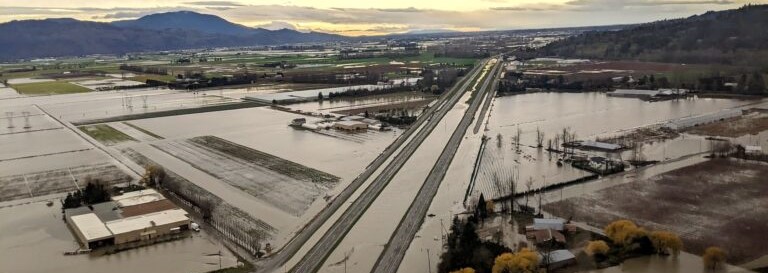New paper finds restoring the lake will help in climate adaptation, endangered species restoration and Indigenous reconciliation
A new proposal has emerged in response to the November 2021 floods that swept Sumas Prairie in the Fraser Valley, causing mass evacuations and millions in damages.
Instead of rebuilding the dykes to manage water flows and prevent future floods, scientists at UBC, along with members of the Sumas First Nation and other research partners, suggest an alternative: let Sumas Lake, which was drained in the early 1920s and converted into the farmland known as Sumas Prairie, return to its natural state.
This can be done by buying out properties on the lakebed – a solution that is projected to cost around $1 billion, less than half of the estimated $2.4 billion cost of repairing the dykes and installing a new pump station.
“Dyke rehabilitation programs tend to assume that future waterflows will be predictable, however climate projections show that flooding events are likely to increase in the future – and the water needs somewhere to go,” says study author Riley Finn, a researcher at the Martin Conservation Decisions Lab at UBC in a paper published today in Frontiers of Conservation Science.
“By restoring Sumas Lake – Semá:th Xhotsa – we can help the region adapt to future floods, facilitating climate resiliency in the long term. It is the most ecologically responsible solution for flood management in the region.”
Ecological reconciliation
The authors note that restoring the lake will also promote healthy food systems and ecological reconciliation, addressing the ongoing harms caused by the loss of the lake to the Semá:th people.
Before its conversion to agricultural land, Sumas Lake supported thriving populations of salmon, sturgeon, ducks, and food and medicinal plants, many of which are now endangered.
Chief Dalton Silver, Sumas First Nation said “For the Semá:th people, the lake represented life and livelihood. In 1924, the lake was drained in an instance of land theft, decimating an ecology that supported a rich and diverse Indigenous food system and replacing it with a settler food system.
“My grandpa used to say that in the Coast Salish Territory, Semá:th was the central location where the people used to gather. The people gathered in the summertime as we had Semá:th Lake that once offered every species of fish right there at the front of our village and in the wintertime, people gathered there from all parts of the Coast Salish Territory for the winter ceremonies.”
Managed retreat
The study integrates Indigenous laws and oral tradition and the concept of “managed retreat” – the purposeful relocation of people and infrastructure to safer areas.
“In a time when climate-change induced flooding is predicted to increase, our study shows that incorporating Indigenous laws and knowledge is essential for developing more sustainable and just solutions,” said Dr. Tara Martin, the study’s senior author and a professor of forest and conservation sciences at UBC. “We need to explore innovative solutions, not just build more dykes.”
Humans seem to want to build bigger and better infrastructure but it is always at the detriment of our ecosystem and environment, added co-author Murray Ned, a member of the Sumas First Nation and executive director of the Lower Fraser Fisheries Alliance.
“Mother Nature signaled to us in 1990 and 2021 that the spirit of the Semá:th Xhotsa is alive and well, and ready to return with or without our cooperation. This research demonstrates that there are more economical and logical options that would allow us to reconcile some of the past harms of draining the lake a hundred years ago, and still maintain agricultural opportunities and the farming community in the region,” said Ned.










why the whole lake brouhgt back some little lakes dambed hydro water for farmers fishing camping